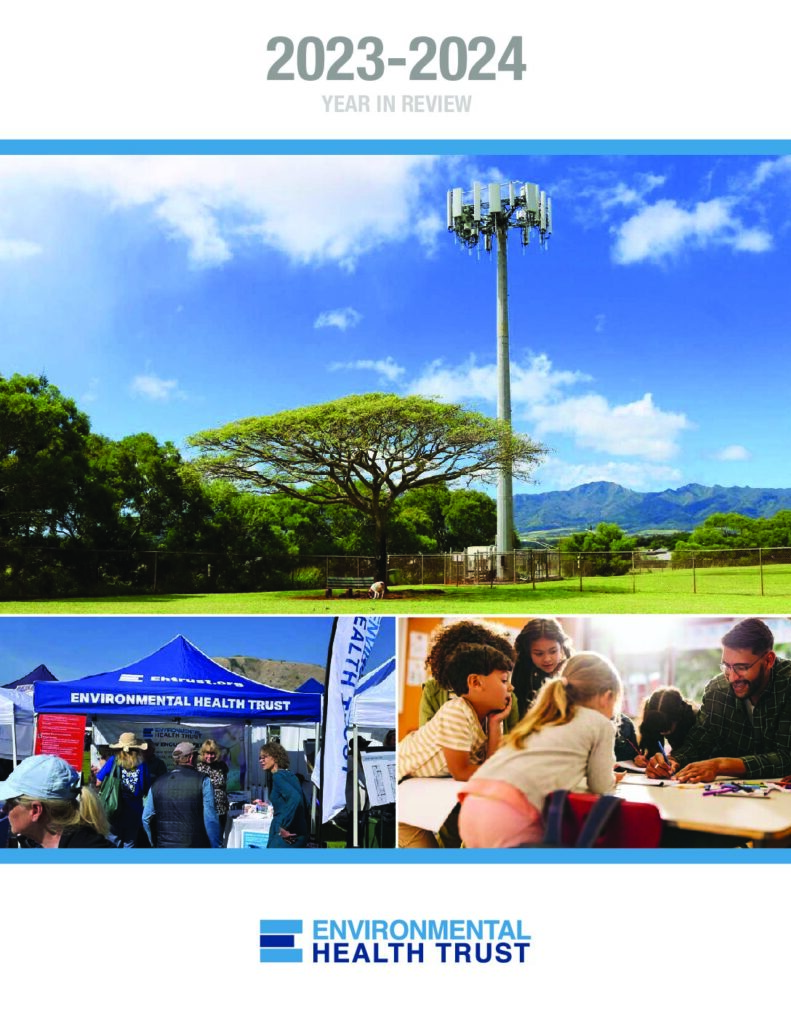Electromagnetic Sensitivity
Balmori, A. (2022). Evidence for a health risk by RF on humans living around mobile phone base stations: From radiofrequency sickness to cancer. Environmental Research, 214, 113851.
Belpomme, D., Campagnac, C., & Irigaray, P. (2015). Reliable disease biomarkers characterizing and identifying electrohypersensitivity and multiple chemical sensitivity as two etiopathogenic aspects of a unique pathological disorder. Reviews on Environmental Health, 30(4), 251–271.
Belpomme, D., Carlo, G. L., Irigaray, P., Carpenter, D. O., Hardell, L., Kundi, M., Belyaev, I., Havas, M., Adlkofer, F., Heuser, G., Miller, A. B., Caccamo, D., De Luca, C., von Klitzing, L., Pall, M. L., Bandara, P., Stein, Y., Sage, C., Soffritti, M., … Vorst, A. V. (2021a). The Critical Importance of Molecular Biomarkers and Imaging in the Study of Electrohypersensitivity. A Scientific Consensus International Report. International Journal of Molecular Sciences, 22(14), Article 14.
Belpomme, D., & Irigaray, P. (2022). Why electrohypersensitivity and related symptoms are caused by non-ionizing man-made electromagnetic fields: An overview and medical assessment. Environmental Research, 212(Pt A), 113374.
Belpomme, D., & Irigaray, P. (2020). Electrohypersensitivity as a Newly Identified and Characterized Neurologic Pathological Disorder: How to Diagnose, Treat, and Prevent It. International Journal of Molecular Sciences, 21(6), E1915.
Belyaev, I., Dean, A., Eger, H., Hubmann, G., Jandrisovits, R., Kern, M., Kundi, M., Moshammer, H., Lercher, P., Müller, K., Oberfeld, G., Ohnsorge, P., Pelzmann, P., Scheingraber, C., & Thill, R. (2016). EUROPAEM EMF Guideline 2016 for the prevention, diagnosis and treatment of EMF-related health problems and illnesses. Reviews on Environmental Health, 31(3), 363–397.
Bevington, M. (2019). The Prevalence of People With Restricted Access to Work in Man-Made Electromagnetic Environments. Journal of Environment and Health Science, 5, 1–12.
Bordarie, J., Dieudonné, M., Ledent, M., & Prignot, N. (n.d.). A qualitative approach to experiential knowledge identified in focus groups aimed at co-designing a provocation test in the study of electrohypersensitivity. Annals of Medicine, 54(1), 2363–2375.
De Luca, C., Chung Sheun Thai, J., Raskovic, D., Cesareo, E., Caccamo, D., Trukhanov, A., & Korkina, L. (2014). Metabolic and Genetic Screening of Electromagnetic Hypersensitive Subjects as a Feasible Tool for Diagnostics and Intervention. Mediators of Inflammation, 2014, 924184.
Dieudonné, M. (2020). Electromagnetic hypersensitivity: A critical review of explanatory hypotheses. Environmental Health, 19(1), 48.
Dieudonné, M. (2019). Becoming electro-hypersensitive: A replication study. Bioelectromagnetics, 40(3), 188–200.
Dieudonné, M. (2016). Does electromagnetic hypersensitivity originate from nocebo responses? Indications from a qualitative study. Bioelectromagnetics, 37(1), 14–24.
Greco, F., Garnier, O., Macioce, V., & Picot, M. C. (2023). Prevalence of Migraine Disease in Electrohypersensitive Patients. Journal of Clinical Medicine, 12(12), Article 12.
Hardell, L., & Nilsson, M. (2023). Case Report: The Microwave Syndrome after Installation of 5G Emphasizes the Need for Protection from Radiofrequency Radiation. Annals of Case Reports.
Hardell, L., & Koppel, T. (2022). Electromagnetic hypersensitivity close to mobile phone base stations – a case study in Stockholm, Sweden. Reviews on Environmental Health.
Hedendahl, L., Carlberg, M., & Hardell, L. (2015). Electromagnetic hypersensitivity—An increasing challenge to the medical profession. Reviews on Environmental Health, 30(4), 209–215.
Heuser, G., & Heuser, S. A. (2017). Functional brain MRI in patients complaining of electrohypersensitivity after long term exposure to electromagnetic fields. Reviews on Environmental Health, 32(3), 291–299.
Leszczynski, D. (2022). The lack of international and national health policies to protect persons with self-declared electromagnetic hypersensitivity. Reviews on Environmental Health.
McCarty, D. E., Carrubba, S., Chesson, A. L., Frilot, C., Gonzalez-Toledo, E., & Marino, A. A. (2011). Electromagnetic hypersensitivity: Evidence for a novel neurological syndrome. The International Journal of Neuroscience, 121(12), 670–676.
Nilsson M, Hardell L. (2023) Development of the Microwave Syndrome in Two Men Shortly after Installation of 5G on the Roof above their Office. Ann Clin Case Rep. 8: 2378.
Redmayne, M., & Reddel, S. (2021). Redefining electrosensitivity: A new literature-supported model. Electromagnetic Biology and Medicine, 40(2), 227–235. https://doi.org/10.1080/15368378.2021.1874971
Sage, C. (2015). The implications of non-linear biological oscillations on human electrophysiology for electrohypersensitivity (EHS) and multiple chemical sensitivity (MCS). Reviews on Environmental Health, 30(4), 293–303.
Stein, Y., & Udasin, I. G. (2020). Electromagnetic hypersensitivity (EHS, microwave syndrome) – Review of mechanisms. Environmental Research, 186, 109445.
Verma, R., Swanson, R. L., Parker, D., Ould Ismail, A. A., Shinohara, R. T., Alappatt, J. A., Doshi, J., Davatzikos, C., Gallaway, M., Duda, D., Chen, H. I., Kim, J. J., Gur, R. C., Wolf, R. L., Grady, M. S., Hampton, S., Diaz-Arrastia, R., & Smith, D. H. (2019). Neuroimaging Findings in US Government Personnel With Possible Exposure to Directional Phenomena in Havana, Cuba. JAMA, 322(4), 336–347.
Chemical sensitivity including the issue of electromagnetic radiation
Masri, S., CS Miller, RF Palmer, and NA Ashford (2021). “Toxicant-Induced Loss of Tolerance for Chemicals, Foods and Drugs: Assessing Patterns of Exposure Behind a Global Phenomenon” Environmental Sciences Europe. 33:65 Available at: https://rdcu.be/cls7y
Miller, CS, RF Palmer, TT Dempsey, NA Ashford, and LB Afrin (2021). “Mast Cell Activation May Explain Many Cases of Chemical Intolerance” Environmental Sciences Europe. 33:129 Available at: https://rdcu.be/cBxkP
Review Papers
Davis, D., Sears, M. E., Miller, A. B., & Bray, R. (2017). Microwave/Radiofrequency Radiation and Human Health: Clinical Management in the Digital Age. In A. Cohen, F. S. vom Saal, & A. Weil (Eds.), Integrative Environmental Medicine (p. 0). Oxford University Press.
Davis, D., Birnbaum, L., Ben-Ishai, P., Taylor, H., Sears, M., Butler, T., & Scarato, T. (2023). Wireless technologies, non-ionizing electromagnetic fields and children: Identifying and reducing health risks. Current Problems in Pediatric and Adolescent Health Care, 53(2), 101374.
International Commission on the Biological Effects of Electromagnetic Fields (ICBE-EMF), (2022). Scientific evidence invalidates health assumptions underlying the FCC and ICNIRP exposure limit determinations for radiofrequency radiation: implications for 5G. Environ Health. Oct 18;21(1):92.
McCredden, J. E., Cook, N., Weller, S., & Leach, V. (2022). Wireless technology is an environmental stressor requiring new understanding and approaches in health care. Frontiers in Public Health, 10.
Miller, A. B., Sears, M. E., Morgan, L. L., Davis, D. L., Hardell, L., Oremus, M., & Soskolne, C. L. (2019). Risks to Health and Well-Being From Radio-Frequency Radiation Emitted by Cell Phones and Other Wireless Devices. Frontiers in Public Health, 7.






